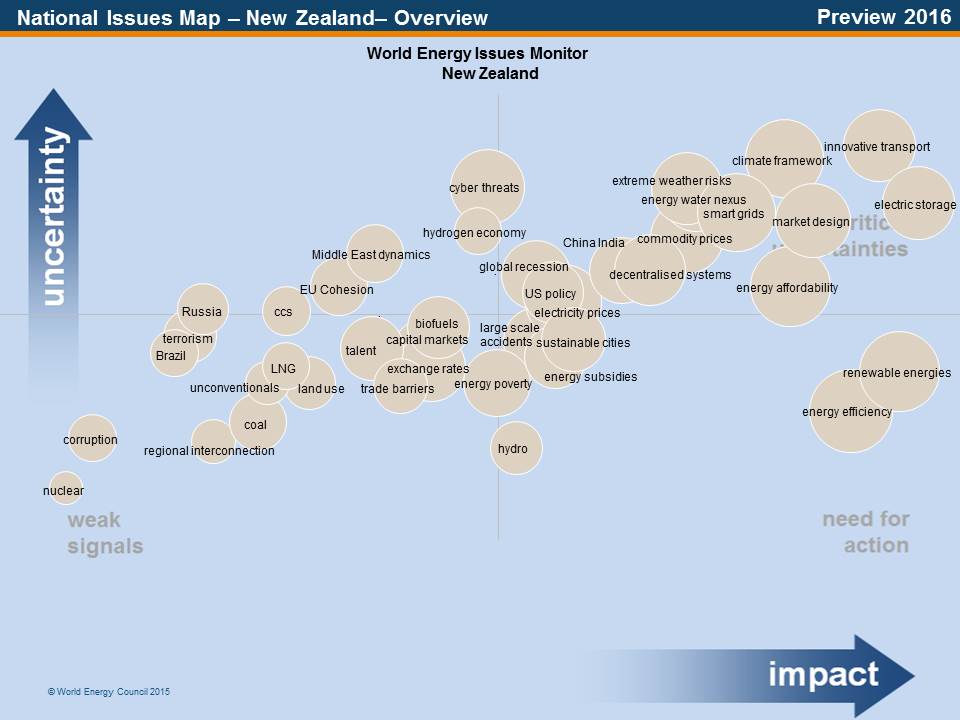The newly released World Energy Issues Monitor, the World Energy Council’s annual survey for New Zealand, shows the issues keeping New Zealand energy executives awake at night reflect rapidly changing energy needs and the challenge of achieving a more resilient energy system.
The Hon David Caygill, Chair of the BusinessNZ Energy Council, says, “The uncertainties surrounding the climate framework and market design have this year been joined by innovative transport and electric storage. Smart grids, extreme weather risks and the energy-water nexus complete the complement of high-concern and high impact issues. Concerns about energy prices and affordability have matured into an issue, alongside the perennials of energy efficiency and renewable energies.
“New Zealand energy executives seem to believe that a future of new innovative market, technological and regulatory models, combined with a future of renewable energies will define the future of our energy sector.
“The map sends a clear signal to both business leaders and policy-makers to keep up with unfolding technological developments and the rise of the pro-sumer in order to allow new business models to emerge, compete, and deliver competitive prices.
“One thing is clear, energy resilience – the challenges it creates and the new and innovative policy, finance, and consumer responses to achieve it – are weighing on the minds of New Zealand energy executives.
“This finding reinforces the recently released BEC2050 Energy Scenarios where the NZ energy sector came together to map out two plausible futures for the energy sector. The report showed that transformative change is possible, but that policy and investment choices and trade-offs will be needed along the way. The choices and trade-offs being made today will have significant implications for the energy system of the future.
“Resilience is the theme of the Asia-Pacific Energy Leaders’ Summit taking place at the InterContinental Hotel in Wellington this Wednesday and Thursday, with delegates from over 18 countries. This is the first time energy leaders, top-level business executives, policymakers and thought leaders from around the world have been brought together to tackle this growing global concern.
More about the Asia-Pacific Energy Leaders’ Summit here.
More about the BEC 2050 energy scenarios here.
World Energy Issues Monitor Full Report.
Contact: David Caygill 027 432 5228 or John Carnegie 021 375 061
Notes to Editors
About the World Energy Council (WEC)
The World Energy Council’s network of 100 national committees represents over 3,000 member organisations including governments, industry and expert institutions, with the mission of promoting the sustainable supply and use of energy for the greatest benefit of all. www.worldenergy.org
About the BusinessNZ Energy Council (BEC)
The BusinessNZ Energy Council (BEC) is a group of New Zealand organisations taking on a leading role in creating a sustainable energy future for New Zealand. The BEC is the New Zealand Member Committee of the World Energy Council (WEC). All BEC members are automatically members of the WEC. www.bec.org.nz
The 2016 Issues Monitor
The World Energy Issues Monitor is the WEC’s annual assessment of the issues impacting the global and regional energy sector based on the views of the WEC’s energy leadership community. It surveys the views of over 1200 energy leaders in 90 countries to identify the key uncertainties in the sector while highlighting the areas where action is most required to enable the sustainable supply and use of energy. The 2016 report includes assessment of six world regions and over 30 country deep dives. The report highlights 40 issues and their perceived impact, uncertainty, and urgency for global energy leaders and experts.
How to read the Issues Monitor

- Critical uncertainties: Issues with high uncertainty and high impact (in the top-right quadrant) are the ‘critical uncertainties’ with no clear path of action which keep energy leaders most awake at night. These issues need to be part of the energy leaders’ dialogue and scenario analysis.
- Action priorities: The issues in the high-impact and low-uncertainty space are those which keep energy leaders most busy (bottom-right, ‘action issues’).
- Weak signals: The low-impact and low-uncertainty issues (bottom-left quadrant) include those of perceived lesser importance or those that are still not fully understood and in need of further investigation.
- The responses are translated into issue monitors with the three assessed dimensions: the impact of an issue on the energy sector – this forms the x axis; the degree of uncertainty related to its impact – this forms y axis; the urgency with which we need to address the specific issue – represented by the proportional size of the issue bubble where a larger size corresponds to a higher degree of urgency.
Email:
